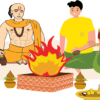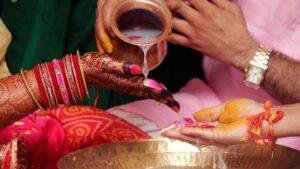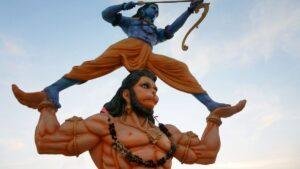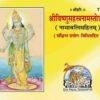One of the most extensively observed and joyous occasions in Hindu culture is Durga Ashtami. The eighth day of Shukla Paksha, or Ashtami tithi, is when people celebrate Durgashtami each month. This is the reason why Maas Durgashtami or Masik Durgashtami are common names for this occasion.
To obtain the blessings of Goddess Durga, the most auspicious days to do so are thought to be Durga Ashtami during Navratri, particularly Chaitra and Shardiya Navratri. Recognized as Maha Ashtami, Durga Ashtami falls on Shardiya Navratri and is revered by Hindus worldwide.
Significance of Durgashtami
As the name implies, Durga Ashtami is devoted to Goddess Durga. Chamunda, one of Maa Durga’s avatars, is said to materialize on her forehead to vanquish Chanda and Munda, the demonic beings who helped Mahishasura carry out his evil schemes. On this day, devotees fast for the entire day in an effort to obtain Goddess Durga’s blessings. It is thought that happiness, prosperity, and good fortune are showered to those who faithfully conduct the Durga Ashtami Vrat.
Ayudha Puja, or the worship of the weapons, or Astra Puja are also performed in a number of Indian groups in remembrance of Maa Durga’s valiant deed. Vira Ashtami is another name for this day.

Benefits of Durgashtami
Spiritual Purification: Believers attribute aiding in spiritual purification to observing Durga Ashtami. Devotees cleanse their minds and souls through prayers and rituals dedicated to Goddess Durga.
Protection and Blessings: Believers attribute invoking blessings to worshipping Goddess Durga on Ashtami. These blessings offer protection against evil forces and negative energies. Devotees seek her divine intervention for guidance and support in their lives.
Strength and Courage: During Durga Ashtami, Goddess Durga manifests as the embodiment of strength and courage. Devotees believe observing this day imbues them with qualities to overcome life’s obstacles and challenges.
Fulfillment of Wishes: Many devotees believe that sincere prayers and offerings made to Goddess Durga on Ashtami can lead to the fulfillment of their desires and wishes. It is a time to express gratitude and seek blessings for prosperity and success.
Health and Well-being: Devotees also seek the blessings of Goddess Durga for good health and well-being. Believers attribute the alleviation of physical ailments to worshipping her on Ashtami. It can bring about healing and rejuvenation.
Durga Ashtami Pooja Rituals
- During the early hours of Durga Ashtami, the idol of Maa Durga with flowers, incense, and sandalwood.
- Kumari Puja, or the adoration of nine unmarried girls between the ages of six and twelve, is another significant aspect of the celebrations.
- On the day of Durgashtami Vrat, devotees refrain from eating anything.
- Devotees recite Durga Chalisa and chant goddess-dedicated mantras during Durgashtami Puja.
- While paying homage to Maa Durga, one can also read the Durga Ashtami Vrat Katha.
- Making a donation to the priests on this day, known as Dakshina, is another significant event.
Legends of Durga Ashtami
The festival of Navratri commemorates the triumph of good over evil. It honors the day that Goddess Durga killed Mahishasura. The sacred trinity of Brahma, Vishnu, and Shiva formed Goddess Durga after Mahishasura defeated Lord Indra.
Every portion of her body received bestowed powers from various Gods. Some texts state that the day of Shukla Paksha Ashtami is when the spirit of Goddess Durga came into being. A tale is associated with Durga Ashtami. According to it, Goddess Chamunda emerged from Mother Durga’s forehead and destroyed Chanda, Munda, and Rakthabija.
On Durga Ashtami, devotees actively worship Goddess Durga as Maha Gauri. Another legend connected to Durga Ashtami is the tale of Mahagauri. Parvati’s skin became black due to the severe penance she underwent in order to obtain Shiva as her spouse. Her incredibly white complexion earned her the title “Maha Gauri.” This resulted in Shiva finally accepting her and washing away her impurities in the Ganga River.

Yearly Dates and Mahurat of 2024
| Name | Date | Mahurat Begins | Mahurat Ends |
| Pausha, Shukla Ashtami | January 18, 2024, Thursday | January 17 | 11:36 AM in (United States) | January 18 | 10:14 AM in (United States) |
| Magha, Shukla Ashtami | February 16, 2024, Friday | February 15 | 10:24 PM in (United States) | February 16 | 9:45 PM in (United States) |
| Phalguna, Shukla Ashtami | March 17, 2024, Sunday | March 16 | 12:08 PM in (United States) | March 17 | 12:22 PM in (United States) |
| Chaitra, Shukla Ashtami | April 16, 2024, Tuesday | April 15 | 2:41 AM in (United States) | April 16 | 3:53 AM in (United States) |
| Vaishakha, Shukla Ashtami | May 15, 2024, Wednesday | May 14 | 6:49 PM in (United States) | May 15 | 8:52 PM in (United States) |
| Jyeshtha, Shukla Ashtami | June 14, 2024, Friday | June 13 | 12:03 PM in (United States) | June 14 | 2:33 PM in (United States) |
| Ashadha, Shukla Ashtami | July 14, 2024, Sunday | July 13 | 5:35 AM in (United States) | July 14 | 7:55 AM in (United States) |
| Shravana, Shukla Ashtami | August 13, 2024, Tuesday | August 11 | 10:25 PM in (United States) | August 13 | 12:01 AM in (United States) |
| Bhadrapada, Shukla Ashtami | September 11, 2024, Wednesday | September 10 | 1:41 PM in (United States) | September 11 | 2:16 PM in (United States) |
| Ashwina, Shukla Ashtami | October 11, 2024, Friday | October 10 | 3:01 AM in (United States) | October 13 | 2:36 AM in (United States) |
| Kartika, Shukla Ashtami | November 9, 2024, Saturday | November 08 | 1:26 PM in (United States) | November 09 | 12:15 AM in (United States) |
| Margashirsha, Shukla Ashtami | December 8, 2024, Sunday | December 07 | 11:16 PM in (United States) | December 08 | 9:32 PM in (United States) |



















Add comment